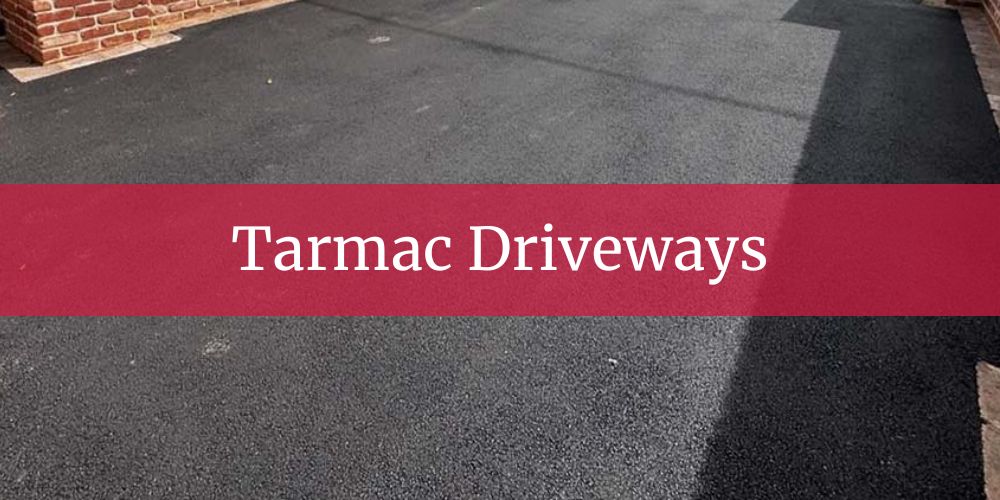Driveways Brentwood installs tarmac driveways across Brentwood, Shenfield, Hutton, Warley and nearby villages. Each driveway is engineered for London Clay with a correctly compacted foundation, laser set levels and drainage planned from the outset using linear channels, gullies or a soakaway where required. You can choose neat granite or steel edging, tie ins to pavements and garage thresholds, and heavy duty surface options for vans or frequent turning. Driveways Brentwood handle survey, design, groundworks, asphalt laying and finishing so you get a smooth, tidy driveway delivered with minimal disruption; book a free site survey and fixed quote in Brentwood today.
A tarmac driveway is a two course asphalt pavement laid hot over a compacted MOT Type 1 base. Typical specifications are AC20 binder at 50 to 60 mm topped with AC6 or stone mastic asphalt at 25 to 30 mm, all compacted within the correct temperature window to achieve density and long service life. We apply tack coats between courses, hot seal tie ins at kerbs and thresholds, and set positive falls of about 1:60 to 1:80 so water runs to channels, gullies or a soakaway sized to BRE guidance because asphalt itself is not permeable. On clay ground we use separation geotextile where appropriate and verify sub base depth against expected loads; for slopes, turning bays or commercial vehicles we can thicken courses or specify polymer modified SMA to improve scuff and rut resistance. Future refresh is straightforward since high spots can be planed, defects patched, a fresh tack applied and a 25 to 40 mm overlay installed to restore texture and colour without rebuilding the base.
What Is A Tarmac Driveway?
A tarmac driveway is an asphalt pavement laid hot over a compacted granular base to create a smooth, continuous surface for parking and access. Most domestic drives are built as a two course system with a binder course such as AC20 at 50 to 60 mm and a wearing course such as AC6 or stone mastic asphalt at 25 to 30 mm. Layers are bonded with a tack coat and compacted while hot so the mix achieves the right density and long service life. The result is tidy, quiet to drive on, and quick to install compared with many modular surfaces. In Brentwood we engineer tarmac driveways for London Clay, starting with controlled excavation, a separation geotextile where soils are variable, and MOT Type 1 compacted in layers to form a stable base. Levels are set with lasers and positive falls of about 1:60 to 1:80 carry water away from façades. Because asphalt is not permeable, we integrate linear threshold channels with silt traps, gullies, or a soakaway sized to BRE guidance, and we protect the damp proof course at doorways. Tie ins to pavements and garage slabs are hot sealed and edges are restrained with neat granite or steel trims for crisp margins.
Installation quality makes the difference. We manage mix temperature and rolling windows, apply tack between courses, and hot seal joints so water cannot track into the build up. Day joints are planned to fall at natural breaks, and manhole covers are set level and aligned for safe, clean transitions. For heavier vehicles, slopes, or tight turning bays common on Shenfield and Hutton plots, we can thicken courses, specify stone mastic asphalt, or use polymer modified binders to improve scuff and rut resistance. Aftercare is straightforward. In the first weeks avoid stationary steering and protect the surface from fuel spills, then routine maintenance is limited to sweeping and occasional gentle washing. Keep channels and silt traps clear so drainage remains effective. When the surface eventually loses texture or colour, a refresh is simple because high spots can be planed, defects patched, a fresh tack applied, and a 25 to 40 mm overlay laid without rebuilding the base.
Have a question about an upcoming project?
Why Should You Choose A Tarmac Driveway In The Brentwood Area?
Tarmac suits Brentwood because it delivers a smooth, robust driving surface quickly and cost effectively when the base and drainage are engineered for London Clay. It handles daily commuter traffic and tight turning without the rattle of loose aggregates, and it looks clean from the kerb with crisp, straight margins. With neat tie ins at pavements and garage thresholds, a tarmac driveway offers a tidy, low fuss finish that complements both modern homes in Shenfield and period properties in South Weald. Detail and performance are built in from the start. We prepare a stable MOT Type 1 foundation on clay, set levels with lasers, and plan drainage before any asphalt is laid. Edges are restrained with granite setts or slim steel trims for long straight lines and controlled borders, and recessed covers are set level so services remain accessible but discreet. For heavier vehicles, slopes or frequent turning bays we can upgrade to stone mastic asphalt or polymer modified binders to resist scuffing and rutting.
Because asphalt itself is not permeable, drainage is designed into the build. We create positive falls of about 1:60 to 1:80 away from façades and into linear threshold channels with silt traps, gullies, or a soakaway sized to BRE guidance. Clearances to the damp proof course are protected at door thresholds, and all tie ins are hot sealed so water cannot track into the construction. This approach keeps façades dry and surfaces free of puddles even in heavy rain. Installation follows proven two course practice for long service life. A typical specification uses an AC20 binder at 50 to 60 mm topped with AC6 or SMA at 25 to 30 mm, both compacted hot and bonded with a tack coat between layers. Temperature and rolling windows are managed carefully, joints are hot sealed, and day joints are planned at natural breaks for a uniform appearance. When the time comes to refresh, we can plane high spots, patch defects, apply fresh tack and install a 25 to 40 mm overlay without rebuilding the base.
- Fast installation with minimal disruption and a clean, modern look
- Engineered for London Clay with the right base, levels and planned drainage
- Heavy duty options for vans, slopes and tight turning areas
- Crisp edging and flush recessed covers for a professional finish
- Simple future overlay to restore colour and texture without full reconstruction
1. Fast installation with minimal disruption and a clean, modern look
Tarmac can be programmed efficiently because materials arrive hot, are placed in continuous runs, and compacted immediately, which shortens site time and reduces neighbour impact. We coordinate plant and deliveries so the binder and surface courses follow each other without cold joints, and we stage works to preserve pedestrian access to front doors wherever feasible. The mat is laid with a paver for consistent thickness, then rolled with the correct sequence of breakdown, intermediate and finish passes so texture closes evenly and joints knit while still hot. Tack coats are sprayed uniformly to bond layers, edges are trimmed and hot sealed, and vulnerable margins near walls or kerbs are compacted with smaller rollers or vibration plates to avoid damage. Because there are no modules to set out or cut, reinstatement is straightforward, and once the surface has cooled and density is achieved, access can resume without the grout cure times associated with block or stone. The result is a single, smooth plane that looks tidy from the kerb, runs quietly under tyres, and is ready for everyday use with minimal disruption.
2. Engineered for London Clay with the right base, levels and planned drainage
On Brentwood’s clay we begin with controlled excavation to a firm formation, proof-roll to identify soft spots, and add a separation geotextile where soils are variable so fines do not migrate into the base. A foundation of MOT Type 1 is placed in thin lifts and compacted to the specified depth, typically 150 to 200 mm for domestic driveways, then profiled accurately to pre-set falls before any asphalt is laid. Levels are set with a rotary laser to create positive drainage of about 1:60 to 1:80 away from façades and toward collection points, with subtle crossfall introduced at wide bays to prevent flat spots. Linear threshold channels with silt traps and rodding access protect the damp proof course while enabling near level door thresholds, and gullies or a soakaway are sized to BRE 365 guidance where infiltration or attenuation is required. Tie-ins to pavements and garage slabs are planned so finished levels are flush, cold joints are avoided, and water cannot track into the construction; kerb lines are kept true and joints are hot sealed to exclude moisture. This combination of stable base, precise levels and designed outfalls keeps façades dry, prevents ponding in wheel tracks, and supports long service life on clay ground.
3. Heavy duty options for vans, slopes and tight turning areas
Where loads are higher or steering forces are concentrated, we upgrade the asphalt specification so the surface resists scuffing and rutting. Binder and surface courses are thickened, for example AC20 dense binder at 60–80 mm with an AC10 or SMA 25–40 mm wearing course, compacted while hot to achieve target density. On slopes and tight turning circles we specify stone mastic asphalt with high-PSV aggregate, or polymer-modified binders that retain stiffness in summer heat yet stay resilient in winter. Local reinforcement can be introduced at entrances and bays by increasing course thicknesses, tightening joint control, and adding extra rolling passes to close texture. Sub-base stiffness is verified and improved where necessary so the pavement acts as a system, not just a thicker top. Edges and upstands in these areas are detailed for impact, with stronger restraints and hot-sealed interfaces to stop ravel and keep margins straight.
4. Crisp edging and flush recessed covers for a professional finish
Borders in granite setts or slim steel and aluminium trims protect the asphalt edge and provide the straight reference that makes a driveway look sharp from the kerb. Setts are bedded and haunched in concrete; metal profiles are pinned closely on curves and set to finished level so compaction achieves a clean, continuous line. Recessed inspection covers are raised on adjustment rings, bedded solid, and set absolutely flush, then hot-sealed around the frame so water cannot track into the structure; load classes are selected appropriately, typically B125 for cars or D400 where occasional heavier vehicles cross. Kerb lines are kept true, thresholds are formed to protect the damp-proof course while allowing smooth access, and cold joints are avoided by planning paver runs and hot jointing. We also coordinate grille styles and colours with edging so drainage elements blend into the scheme. The result is a coherent surface where services remain accessible but the visual line is uninterrupted.
5. Simple future overlay to restore colour and texture without full reconstruction
When the wearing course loses texture or colour, refurbishment is efficient because the engineered base remains intact. We survey levels and drainage, plane high spots and any oxidised or cracked areas, regulate low zones, and clean thoroughly before applying a uniform tack coat at the correct application rate. Ironwork is adjusted to finished level, edges are keyed in, and a new 25–40 mm surface course is laid and compacted within temperature and rolling windows for durable bond. Where reflective cracking is a risk, a stress-absorbing membrane or regulating layer is installed before the overlay to extend life. Tie-ins to pavements and garage slabs are hot-sealed and feathered neatly so the new surface reads as one plane. This planned overlay restores colour, texture and skid resistance with minimal disruption, while preserving the investment in the foundation and binder below.

